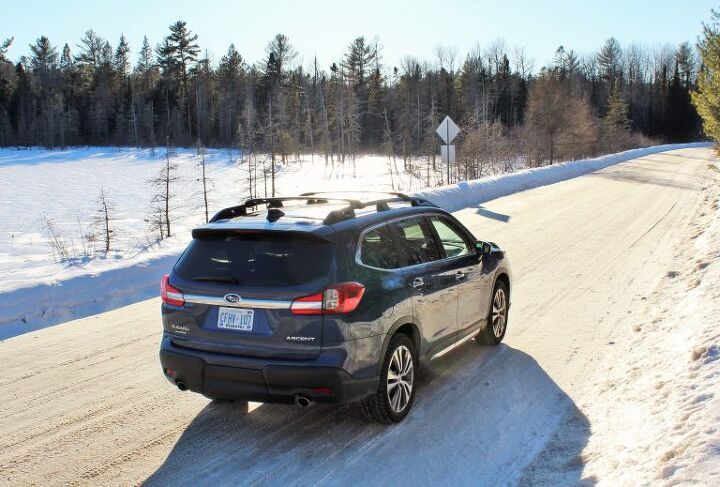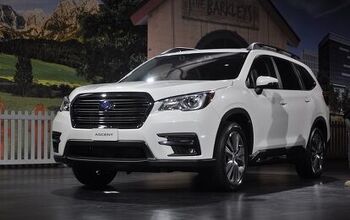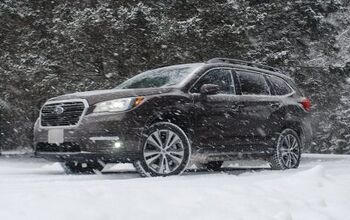2019 Subaru Ascent Premier Review - In a Big Country

2019 Subaru Ascent Premier
Approaching my Ascent tester behind a not-so-local dealer, I felt a presence. Like a pre-war bank, this thing was solid, monolithic, immovable, looming over all of humanity and granting entry to only a choice few. Given the profit Subaru’s going to make off these things, it’s not an inaccurate comparison.
The last Subaru I drove was an Impreza. Not a WRX or its hotter sister, but a stock Impreza sedan. You don’t see many of them. Before that, it was a Crosstrek. Or was it a Forester? No matter, really. Before that, it was a friend’s short-lived SVX, some 16 or so years ago.
Compared to those compact rides, the midsize Ascent crossover is like the HMS Dreadnought moored alongside a torpedo boat, and that’s exactly what Americans — or what Subaru thinks Americans — want. Thankfully, having found myself behind the wheel of a great number of crossovers of late, the Ascent at least held some quirks to set itself apart.
I know, I know, Matthew Guy covered much of this same ground not long ago in his Ascent review, but two observations are better than one. Bear with me!
Easing the Ascent’s bulk out onto a disgustingly slush-filled February street, the crossover’s firm and supportive seats positively oozed Subaru; it’s a comfort I’ve come to expect from the brand, and it’s one I appreciate. Owners won’t want for coddling. It helps that this was a top-flight Premier (the equivalent of a Touring trim in the U.S.) decked out with every last bell and whistle; rich brown leather covering the seven chairs (larger broods can order eight), EyeSight driver assist features up the wazoo, and, of course, the sense of invulnerability afforded by a high-riding perch.
Get new and used Subaru Ascent pricing here!
In high-speed highway driving, the Ascent’s steering felt … effortless. A little too effortless. Searching in vain for a sport mode button or knob to firm things up, I realized this vehicle’s mission. It isn’t meant to thrill moms and dads on the nights the kids are at their grandparents, or even impress the less aged coworkers at their office. It isn’t meant to get the younger crowd hot under the collar at the idea of buying a crossover. The pretense of sportiness seen with so many other vehicles in this category? Absent. No, the Ascent is just a lot of rolling space. Capable, well buttoned-up space that’s easy for anyone to drive, regardless of arm strength.
Basically, Job One for any crossover. It’s easy to forget that Subaru’s a newbie to the midsize segment.
In a burst of equity, Subaru offers but one powertrain in the Ascent, regardless of trim, and it’s an unusual one — a turbocharged 2.4-liter boxer four, good for 260 hp and 277 lb-ft of torque, mated to a continuously variable transmission. In a fairly homogeneous field, Subaru offered something different under the hood.
And there’s nothing wrong with that, except for the fact that the engine’s fairly noisy, and only in a good way after the thing really warms up. It was frigid the week I had the Ascent, and taking off after a cold startup prompted the same intrusive CVT whine Mr. Guy complained about. On one particularly vortex-plagued morning, the tranny acted like a conventional autobox that couldn’t get out of first gear.
Would the revs ever drop? I waited with baited breath.
On warmer days, the boxer’s truck-like rumble stirred something primal in this driver’s psyche, though buyers of vehicles with a similar price tag would probably demand a little more sound-deadening insulation with their ride.
It snowed that week, too. Oh God, did it snow, and it was in this inclimate weather that time spent behind the Ascent’s wheel entered the realm of “fun.” Subaru’s ever-present symmetrical full-time all-wheel drive (was there ever an automotive term burned so deeply into the public consciousness?) ensured that its largest model is just as adept at tackling the white stuff as any other of the brand’s offerings, blasting through snow like a record producer and not afraid to get a little tail happy when urged. Flappy paddles — the only nod to performance in sight — came in handy on the wintry backroads, through I wasn’t able to find any inclines steep enough to give drivetrain-nannying X-Mode (with Hill Descent) a whirl.
While there’s no chance of heart palpitations during acceleration and passing maneuvers, your average Ascent owner likely won’t find its power lacking, nor will they find much to gripe about on rough roads. As always, taller sidewalls would have helped soften the blow of urban cracks and crevasses, but alas, loaded press fleet crossovers call for 20-inchers — even in winter.
Further evidence of this vehicle’s true purpose can be found in the fact the Ascent, regardless of trim, has not four, not eight, not 12, but 19 cupholders. America! The Beverage King Ascent clearly does not wish to see occupants grow dehydrated during long road trips. Entertainment won’t be an issue, either — at least, not in this high-zoot trim level, where every occupant has access to a USB port. There’s enough connection points of various types in the Ascent’s cabin to keep an FBI surveillance team humming away for hours.
It’s nice that Subaru went with a fairly stodgy profile for its big guy, otherwise I’d have grazed my scalp while sitting in the back row. Didn’t happen here. I was pleased to find climate vents back there, too, as third-row occupants needn’t adopt the role of steerage-class passengers in a coming-to-America film.
While Subaru’s two-screen center stack presents a familiar sight in the Ascent, another quirk quickly made itself known. On an undulating freeway, the crossover’s light steering (it starts to tighten up over 40 mph, but not enough for my liking) left me feeling uneasy. Time to bolster the defences. Unfortunately, a cursory scan of the steering wheel and dash showed no trace of a lane-hold switch in all the usual hangouts. It was only after I exited the freeway and stopped at a light did I discover the little scamp hiding above my head, near the sunglasses holder.
Subaru does a good job creating a rich-feeling, semi-premium cabin, and the model’s capability in bad weather and backcountry shouldn’t be a matter of doubt. I only wish I had a chance to test it in summer, if only to gauge its fuel economy. Despite its four-cylinder powerplant, the cold weather, soft winter rubber, and excessive idling (defrosting can take time) all conspired to return a combined figure of 15.7 mpg for the week. The EPA rates it at 22 mpg combined.
The verdict? A solid effort from Subaru — it’s a vehicle that gets the basics right, minor quibbles aside. However, if you can live without a panoramic sunroof, 20-inch wheels, stereo upgrade, and ultra-sumptuous seats, you might find the purchase of a lower-trim Ascent easier to rationalize.
[Images: Steph Willems/TTAC]

More by Steph Willems
Latest Car Reviews
Read moreLatest Product Reviews
Read moreRecent Comments
- Analoggrotto With Kia Hyundai you are guaranteed to have the best Maintenance and Service experience in the industry. Complementary diagnostics, open book fees schedules and adherence to published rates with no attempts to tack extra work on are part of the HMC Gold Standard of Service. Recalls are the lowest in the industry but when you bring your Hyundai Genesis Kia vehicle in for Feature Improvement, rest assured that it will be taken care of to the highest pentagon standards, fully free of charge with no pressure for paid work or service unless requested. Hyundai Kia have the highest levels of customer ATP loyalty in the industry and Service is key to the best after sales experience.
- MaintenanceCosts In Toyota's hands, these hybrid powertrains with a single motor and a conventional automatic transmission have not been achieving the same kind of fuel economy benefits as the planetary-gear setups in the smaller cars. It's too bad. Many years ago GM did a group of full-size pickups and SUVs with a 6.0L V8 and a two-motor planetary gear system, and those got the fuel economy boost you'd expect while maintaining big-time towing capacity. Toyota should have done the same with its turbo four and six in the new trucks.
- JMII My C7 isn't too bad maintain wise but it requires 10 quarts of expensive 0W-40 once a year (per GM) and tires are pricey due size and grip requirements. I average about $600 a year in maintenance but a majority of that is due to track usage. Brake fluid, brake pads and tires add up quickly. Wiper blades, coolant flush, transmission fluid, rear diff fluid and a new battery were the other costs. I bought the car in 2018 with 18k in mileage and now it has 42k. Many of the items mentioned are needed between 20k and 40k per GM's service schedule so my ownership period just happens to align with various intervals.I really need to go thru my service spreadsheet and put track related items on a separate tab to get a better picture of what "normal" cost would be. Its likely 75% of my spend is track related.Repairs to date are only $350. I needed a new XM antenna (aftermarket), a cargo net clip, a backup lamp switch and new LED side markers (aftermarket). The LEDs were the most expensive at $220.
- Slavuta I drove it but previous style. Its big, with numb steering feel, and transmission that takes away from whatever the engine has.
- Wjtinfwb Rivaled only by the Prowler and Thunderbird as retro vehicles that missed the mark... by a mile.







































Comments
Join the conversation
In the pix it looks like this has a lower floor than most CUVs. Did they reclaim those vertical inches for interior room? Looks like they kept the pointless body lift to a minimum too. Is the hip height a little lower than other CUVs and does that pay off in cornering stability? CUVs are station wagons. Subaru seems to be making minimal effort to pretend otherwise, and I applaud that. The one exception is the front third of the car --- engine compartment and fenders -- which is way too tall, looking ungainly and compromising visibility for nothing. A boxer takes up very little vertical real estate, so there's no practical reason for this.
An old friend of mine recently bought one of these in a lower trim level. His MPG is not far off what you recorded this Winter with the average coming in around 16. In the warmer months that figure climbs to around 19-19.5 so 22 combined is a stretch unless more highway miles is calculated in of course. Tall heavy boxes on large diameter wheels conspire to give not so great MPG despite the cylinder count and trick CVT transmissions. He has had to take it in for an Air bag warning light that would come on randomly while driving and his bluetooth connection has been troublesome but otherwise he seems to like it.